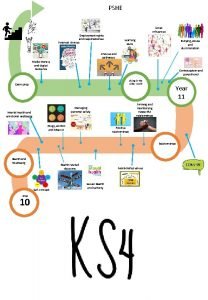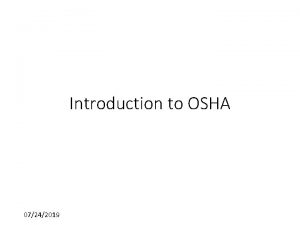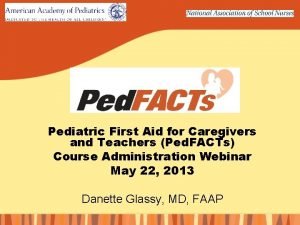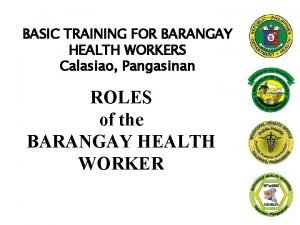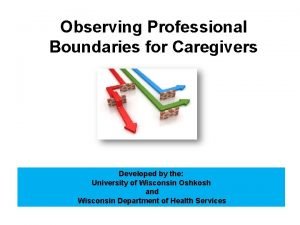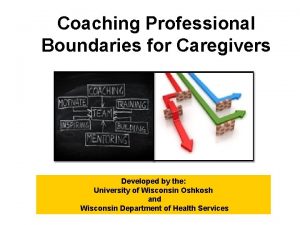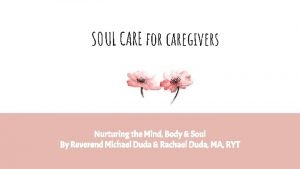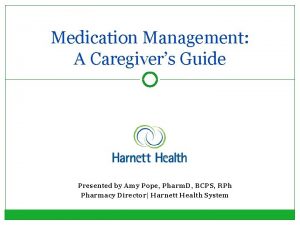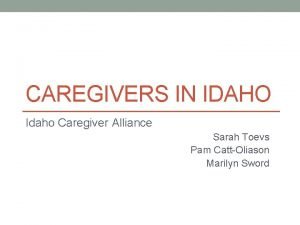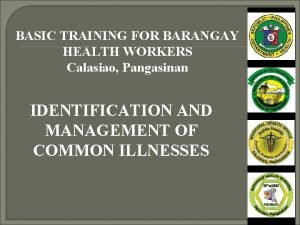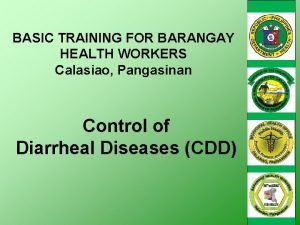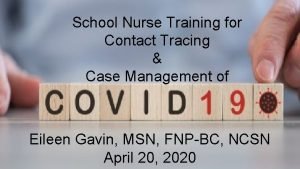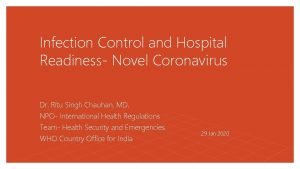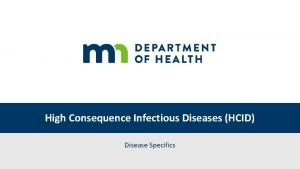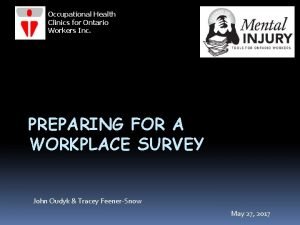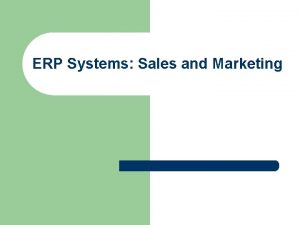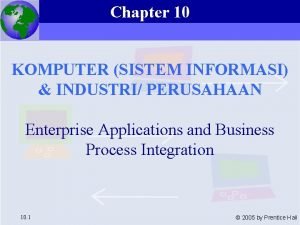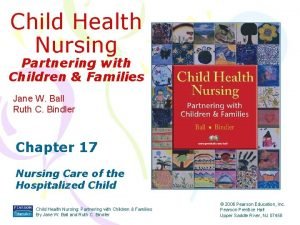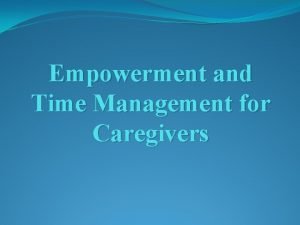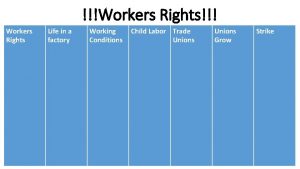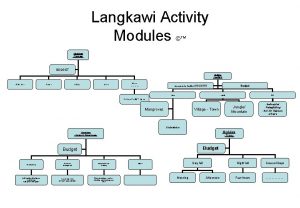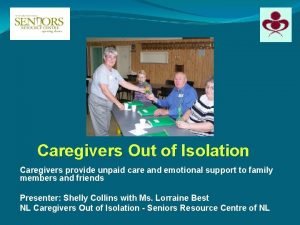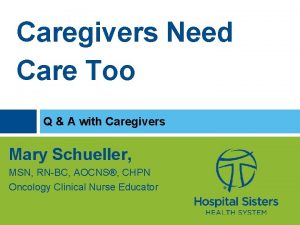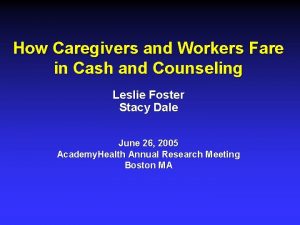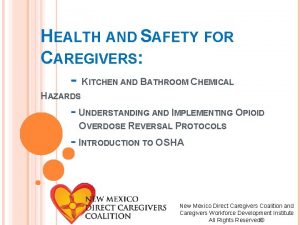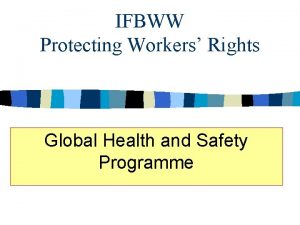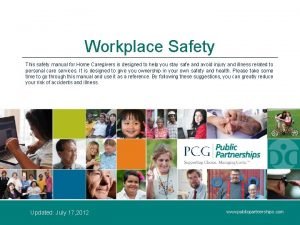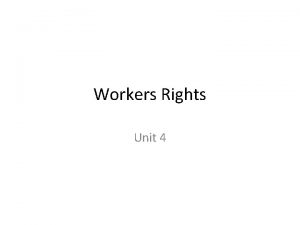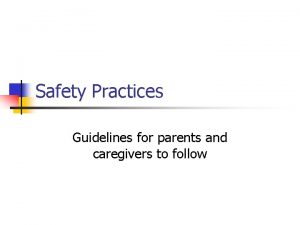Health and Safety for Caregivers MODULES Workers Rights



































- Slides: 35

Health and Safety for Caregivers MODULES: Workers’ Rights and Responsibilities Infection Prevention Musculoskeletal Safety New Mexico Direct Caregivers Coalition • 2016– 2017 All Rights Reserved© 1

This material was produced under grant number SH-29637 -SH 6 from the Occupational Safety and Health Administration, U. S. Department of Labor. It does not necessarily reflect the views or policies of the U. S. Department of Labor, nor does its mention of trade names, commercial products, or organizations imply endorsement by the U. S. Government. 2016– 2017 All Rights Reserved© Health and Safety for Caregivers 2

Introduce Yourself! • What is your name? • How long have you been a caregiver? • What is one thing you love about your job? 2016– 2017 All Rights Reserved© Health and Safety for Caregivers 3

Learning Objectives By the end of this training module, participants will be able to: • Demonstrate proper hand-washing techniques and the use of personal protective equipment (PPE) • Describe how to prevent the transmission of bloodborne pathogens • Demonstrate proper body mechanics for job-related tasks, including lifting • Demonstrate the use of assistive devices, including transfer boards, slide sheets, hydraulic lifts and gait belts • Identify and request the need for assistance in physical tasks • Identify key workers’ rights and employer responsibilities • Raise health and safety concerns with supervisors and file complaints without fear of retaliation 2016– 2017 All Rights Reserved© Health and Safety for Caregivers 4

Agenda • • Welcome, Introductions & Pre-Test Connect and Reflect: Health and Safety Infection Prevention of Musculoskeletal Injuries Workers’ Rights and Responsibilities Review Game Reflection and Action Conclusion & Post-Test 2016– 2017 All Rights Reserved© Health and Safety for Caregivers 5

HEALTH AND SAFETY FOR CAREGIVERS _____________________ Injuries and Risks New Mexico Direct Caregivers Coalition • 2016– 2017 All Rights Reserved© 6

INJURIES & RISKS Back injury • The homecare work environment is not under the control of the employee (the caregiver) or the employer (the agency). • Working in someone else’s home can present unexpected hazards. 2016– 2017 All Rights Reserved© Health and Safety for Caregivers 7

INJURIES & RISKS • Unexpected hazards in home caregiving include: – – – – Animals Loaded weapons in the home Violence Other people Falls due to snow and ice Traffic accidents while driving from home to home Unclean living conditions Source: National Institute for Occupational Safety and Health. (2010). 2016– 2017 All Rights Reserved© Health and Safety for Caregivers 8

INJURIES & RISKS • Due to these hazards, injuries to caregivers are common. They include: – – – – Sprains and strains Musculoskeletal disorders (from moving consumers) Falls Bloodborne diseases and other infections Occupational stress Violence in the home Latex allergy Source: National Institute for Occupational Safety and Health. (2010). 2016– 2017 All Rights Reserved© Health and Safety for Caregivers 9

INJURIES & RISKS • This training has to do with two categories of on-the-job- injury and risk: – Infection Prevention – Musculoskeletal Safety • The goal of this training is to minimize or eliminate these injuries and risks to your health and safety. 2016– 2017 All Rights Reserved© Health and Safety for Caregivers 10

HEALTH AND SAFETY FOR CAREGIVERS _____________________ Infection Prevention New Mexico Direct Caregivers Coalition • 2016– 2017 All Rights Reserved© 11

Caregivers and Infection • Caregivers are exposed to many infections: • • Colds and influenza Respiratory infections Diarrhea (such as from the parasite Giardia) Staph infections (like MRSA) Pneumonia HIV/AIDS Hepatitis B (HBV) and C (HBC) Tuberculosis • Some of these infections can be deadly. 2016– 2017 All Rights Reserved© Health and Safety for Caregivers 12

How do you get sick? • Infections caused by tiny germs called pathogens • Pathogens move from one person to another, spreading disease. This is called transmission of infection: – Breathing in tiny droplets from someone’s coughs and sneezes or talking – Getting stuck by an infected sharp (needle or syringe) – Touching people who are infected – Touching surfaces–such as a chair, bed rail, clothing, bedding–that are infected – Eating, drinking, or touching infected food and water • Experts believe that there are up to 800, 000 sharps injuries every year in U. S. healthcare. Source: National Institute for Occupational Safety and Health. (2014). 2016– 2017 All Rights Reserved© Health and Safety for Caregivers 13

Chain of Infection Source: Centers for Disease Control and Prevention. (1992). Principles of epidemiology, 2 nd ed. Atlanta: U. S. Department of Health and Human Services. 2016– 2017 All Rights Reserved© Health and Safety for Caregivers 14

Monica helps Mr. Lujan shave, an activity that presents numerous opportunities for infection. 2016– 2017 All Rights Reserved© Health and Safety for Caregivers 15

Standard Precautions • Standard Precautions: set of routine practices for avoiding contact with consumers’ body fluids. • Prevent or minimize the spread of infection – especially bloodborne infection (carried in the blood and body fluids). Proper disposal of sharps • Standard Precautions involve: – Handwashing – Use of protective equipment, like gloves – Keeping the environment clean • Use them every time you have contact with consumer. 2016– 2017 All Rights Reserved© Health and Safety for Caregivers 16

Body Fluids and Infection • Body fluids carry germs that can cause serious infection. • What are body fluids? – – – Blood Feces (poop or diarrhea) Urine (pee) Any sores or broken skin Tears Mucous (phlegm) Pus Saliva (spit) Sweat Vomit (throw up) Semen Vaginal fluid Handwashing is an easy and effective way to prevent the spread of infection. 2016– 2017 All Rights Reserved© Health and Safety for Caregivers 17

Handwashing • Take off jewelry on hands and wrists. (Try not to wear jewelry while caregiving!) • Turn on warm (not hot!) water. • Wet your hands under running water. Point your fingertips down. • Apply soap to hands. • With fingertips pointing down, lather hands well. Rub your hands together in a circular motion. Wash carefully between fingers, under nails and up wrists. 2016– 2017 All Rights Reserved© Health and Safety for Caregivers 18

Handwashing • Remember: You need to wash your hands for at least 20 seconds. (Sing “Happy Birthday” twice to yourself, so you know how long 20 seconds is. ) • Rinse off all the soap. Again, make sure your fingertips are pointed down. • Dry hands with a clean paper towel. • Use paper towel to turn off the water and to open the bathroom door. • Drop the wet paper towel into the trash. 2016– 2017 All Rights Reserved© Health and Safety for Caregivers 19

Glove Use Always use the proper procedure to put on, remove and throw away. Putting on Gloves: • Wash and dry your hands carefully. • Get a new pair of gloves from the box. • Pull gloves on carefully. If a glove tears or gets a hole, take it off and start again with a new glove. • Interlace fingers to remove wrinkles, air pockets and achieve a comfortable fit. • If the gloves might get very dirty, wear two pairs of gloves. 2016– 2017 All Rights Reserved© Health and Safety for Caregivers 20

Glove Use Removing and Throwing Away Gloves: • Pinch one of the rubber gloves just below the cuff using your opposite thumb and index finger. • Lift glove away from wrist area. • Pull off the glove, turning inside out. Ball that glove tightly into the palm of your gloved hand. • With ungloved hand, slide your index and middle fingers underneath the cuff of the other (infected) glove. • Now with ungloved hand slide your index and middle finger under the cuff of the other glove; again pulling it off inside out. The first glove you removed should now be inside the second glove. • Pull off that second glove inside out. The first glove you removed should now be inside the second glove. • Throw gloves away. • Wash your hands. 2016– 2017 All Rights Reserved© Health and Safety for Caregivers 21

HEALTH AND SAFETY FOR CAREGIVERS _____________________ Musculoskeletal Safety New Mexico Direct Caregivers Coalition • 2016– 2017 All Rights Reserved© 22

Why Do Direct Caregivers get Musculoskeletal Injuries? • Direct caregivers often have to: – Lift and move consumers without help – Twist and pivot the body while carrying a load – Stand for long periods of time – Reach for things, getting off balance – Work in places that may be cluttered or otherwise hazardous • For these reasons, direct caregivers have more job-related injuries than many other types of healthcare workers. 2016– 2017 All Rights Reserved© Health and Safety for Caregivers 23

Why Do Direct Caregivers get Musculoskeletal Injuries? • Due to these hazards, direct caregivers have high injury rates related to: – The back, shoulder, and neck – Slips, trips and falls – Overexertion (working too hard or too long) – Forceful or frequent lifting, pushing, pulling, holding, carrying and throwing – Repetitive activities Caregiver safely ties garbage bag before disposing. Something is missing in this illustration. What is it? 2016– 2017 All Rights Reserved© Health and Safety for Caregivers 24

Symptoms and Consequences of Musculoskeletal Injury Symptoms of musculoskeletal disorders include: – – – Pain Stiffness Tingling Numbness Swelling Musculoskeletal injury of the hand • Other consequences include: – Lost work time and pay – Consumers lose consistency and quality of care because caregiver cannot work 2016– 2017 All Rights Reserved© Health and Safety for Caregivers 25

Consequences of Musculoskeletal Injury • The health and safety of the direct caregiver has been directly linked to that of the consumer. • Safer, healthier caregiver = Safer, healthier consumer • Your agency saves money when there are fewer worker injuries. • In a safe work environment, everyone wins! 2016– 2017 All Rights Reserved© Health and Safety for Caregivers 26

Advice for a New Caregiver Scenario: In your agency, many caregivers have been absent from work because of musculoskeletal injuries. You don’t have any injuries, though! Your boss asks you to give advice to Ben, a new hire, about how he can avoid musculoskeletal injury. • What advice would you give Ben? What strategies would you recommend? 2016– 2017 All Rights Reserved© Health and Safety for Caregivers 27

Strategies to Avoid Job-Related Injury • Use assistive devices to move or transfer consumers. • Encourage consumer to have assistive devices installed (shower chairs, raised toilet seats, grab bars). • Keep floors clean and dry. • Remove clutter and obstacles in the home (with the consumer’s permission). 2016– 2017 All Rights Reserved© Health and Safety for Caregivers 28

Strategies to Avoid Job-Related Injury • Wear slip-resistant shoes • Make sure there is adequate lighting inside and outside the home, if possible. • Secure loose cords in the house – they are a tripping hazard! 2016– 2017 All Rights Reserved© Health and Safety for Caregivers 29

Strategies to Avoid Job-Related Injury • Be sure ice and snow are removed from walkways. • Raise your awareness of fall hazards. Monica, Mr. Lujan’s caregiver, must stay aware and protect herself from infection and musculoskeletal injury. • Lift items and stand with proper posture. 2016– 2017 All Rights Reserved© Health and Safety for Caregivers 30

Safe Transfer • Many consumers need assistance with transfers. • Transferring safely is important for the safety of the caregiver as well as the safety of the consumer. • We will demonstrate 5 tasks: – Safer lifting of heavy objects – Assisting the consumer to move to the side of the bed and sit up – Using a gait belt to transfer the consumer from bed to wheelchair – Using a gait belt to help a consumer ambulate (walk) – How to handle the consumer’s fall 2016– 2017 All Rights Reserved© Health and Safety for Caregivers 31

HEALTH AND SAFETY FOR CAREGIVERS _____________________ Workers’ Rights and Responsibilities New Mexico Direct Caregivers Coalition • 2016– 2017 All Rights Reserved© 32

Filing a Complaint with OSHA Mailing of a letter • If you believe your workplace is unsafe or unhealthy, tell your employer. • You have the right to file a complaint with OSHA. • File a complaint by mail, by telephone or online • If there is an emergency, use the telephone to file your complaint. • OSHA will keep your complaint confidential. 2016– 2017 All Rights Reserved© Health and Safety for Caregivers 33

Filing a Complaint with OSHA • You have the right to file a complaint without fear of retaliation. • If you believe your employer has retaliated against you for complaining, you can file a Whistleblower Complaint. • See Handout 10 in your Participant Handbook for information on how to file. You can also visit: www. osha. gov 2016– 2017 All Rights Reserved© Health and Safety for Caregivers 34

References • Arizona Direct Care Curriculum Project. (2011). Principles of caregiving: Caregiving fundamentals. Author. Retrieved from http: //www. azdirectcare. org/uploads/2011_All_Fund_POC. pdf • Centers for Disease Control and Prevention. (1992). Principles of epidemiology, 2 nd ed. Atlanta: U. S. Department of Health and Human Services. • Centers for Disease Control and Prevention. (2009). Safe patient handling training for schools of nursing. Retrieved from https: //www. cdc. gov/niosh/docs/2009 -127/pdfs/2009 -127. pdf • Collins, J. W. , Bell, J. L. , and Grönqvist, R. (2010). Developing evidence-based interventions to address the leading causes of workers’ compensation among healthcare workers. Rehabilitation Nursing, 35(6), 226 -261. • Hittle, B. , Agbonifo, N. , Suarez, R. , Davis, K. G. & Ballard , T. (2016) Complexity of occupational exposures for home healthcare workers: Nurses vs. home health aides. Journal of Nursing Management, 24, 1071– 1079. • Kim, I. H. , Geiger-Brown, J. , Triankoff, A. , & Bonet, C. M. (2010). Physically demanding workloads and the risks of musculoskeletal disorders in homecare workers in the USA. Health & Social Care in the Community, 18(5), 445 -455. doi: 10. 1111/j. 1365 -2524. 2010. 00916. x • National Institute for Occupational Safety and Health. (2014). Caring for yourself while caring for others. Retrieved from https: //www. cdc. gov/niosh/docs/2015 -102/default. html • National Institute for Occupational Safety and Health. (2010). Occupational hazards in home healthcare. Retrieved from https: //www. cdc. gov/niosh/docs/2010 -125/pdfs/2010 -125. pdf • Occupational Safety and Health Administration. (n. d. ). Infectious diseases. Retrieved from https: //www. osha. gov/SLTC/healthcarefacilities/infectious_diseases. html • Occupational Safety and Health Administration. (2016). About OSHA. Retrieved from https: //www. osha. gov/about. html 2016– 2017 All Rights Reserved© Health and Safety for Caregivers 35
 Workers rights and responsibilities
Workers rights and responsibilities Employers right
Employers right Osha provides workers the right to crossword answers
Osha provides workers the right to crossword answers Pediatric first aid for teachers
Pediatric first aid for teachers Positive rights and negative rights
Positive rights and negative rights Characteristics of rights
Characteristics of rights Legal rights and moral rights
Legal rights and moral rights Positive rights and negative rights
Positive rights and negative rights Barangay health workers duties and responsibilities
Barangay health workers duties and responsibilities Professional boundaries for in home caregivers
Professional boundaries for in home caregivers Zone of helpfulness
Zone of helpfulness Polyvagal theory
Polyvagal theory Caregivers guide to medication
Caregivers guide to medication Caregivers alliance
Caregivers alliance Littoral rights real estate
Littoral rights real estate Positive and negative rights
Positive and negative rights Positive vs negative rights
Positive vs negative rights Rosalind hursthouse
Rosalind hursthouse Basic training for barangay health workers
Basic training for barangay health workers Basic training for barangay health workers
Basic training for barangay health workers Basic training for barangay health workers
Basic training for barangay health workers C.d.c. covid isolation health workers
C.d.c. covid isolation health workers Covid isolation health workers
Covid isolation health workers C.d.c. covid isolation health workers
C.d.c. covid isolation health workers Covid isolation health workers
Covid isolation health workers Community health workers
Community health workers Health informatics skills
Health informatics skills Occupational health clinic for ontario workers
Occupational health clinic for ontario workers Generic subroutines
Generic subroutines Marketing module in erp
Marketing module in erp Generic subroutines and modules
Generic subroutines and modules Cactus stack in coroutine
Cactus stack in coroutine Generic subroutines and modules
Generic subroutines and modules All crm packages contain modules for prm and erm.
All crm packages contain modules for prm and erm. Health is human rights
Health is human rights Parental rights over child's health
Parental rights over child's health
